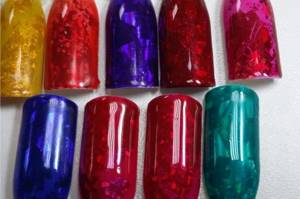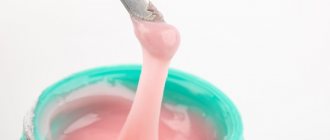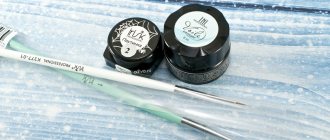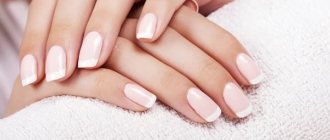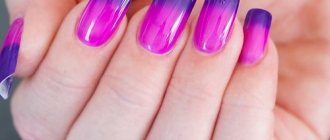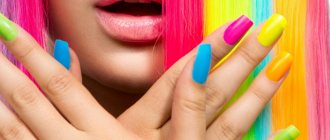New materials for nail services appear today with such frequency that even a true professional sometimes finds it difficult to keep track of all the new products. A beginner can get completely confused.
Single-phase gel for nail extensions has already become quite popular and has acquired an enviable number of fans both among certified specialists and among those who are taking their first steps in understanding the intricacies of this beautiful art. Our article will help you understand all the intricacies of the technology for those who decide to learn how to use single-phase gel for nail extensions, what kind of material it is and what are the features of working with it.
Why is the gel called single-phase?
To find the answer to this question, let's consider the main stages of technology. The extension is carried out in three stages:
- Applying a base coat responsible for adhesion to the surface of the natural nail.
- Shape modeling.
- Coating with a fixing layer that prevents rapid wear of the material and is responsible for the gloss (or for the velvety surface if the design involves a matte texture).
A three-phase system involves the use of three different products, each of which performs a different function. But when it comes to single-phase coating, only one material is needed. What it is? Single-phase gel for nail extensions, of course. He is able to solve all three problems.
A little about the Lina brand
The Lina brand produces products that are very easy to use, allowing you to form nails with a high level of strength. The gel is in great demand among both beginners and more experienced nail technicians.
The country of origin of the products is China. The ratio of quality and price has pushed the brand to a leading position in the creation of gels for the nail plate.
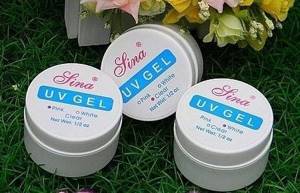
Single-phase reconstructive UV gel Lina is an innovative product that simultaneously plays the role of 3 coatings: base, modeling and finishing.
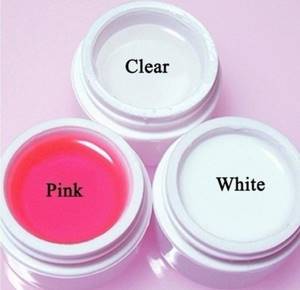
At the same time, the product fully meets all the expectations of nail service specialists. The composition is characterized by excellent adhesion to the nail plate, easy modeling and simple filing.
Material advantages
Often, a single-phase gel becomes the choice of beginners. This is the right decision, because you will have to spend money on just one jar to start getting better at extensions.
Another advantage is the consistency of the material. Compared to three-phase products, it is quite liquid, but not flowing. The gel is convenient to apply and distribute.
Many girls who have tried this type of material claim that it is very obedient, can be easily crimped and can be easily filed. This means that this gel is also suitable for complex arched shapes, such as a pipe.
For many who decided to find out what it is - single-phase gel for nail extensions, the discovery was the huge selection of colors. Manufacturers offer not only classic white, pink and transparent gels, but also a whole palette of camouflages, as well as luxurious opal options, gels with shimmer and sparkles, and luminescent materials. In the palettes of many brands you can easily find gel of any color.
It’s not difficult to understand how to use single-phase gel for nail extensions. If you have experience working with three-phase materials, you will probably enjoy the process. But even if this is your first attempt, you can count on a good result.
However, you should not be deceived and wait for a miracle. Working with any materials for gel manicure has many nuances. If you have the desire and opportunity to take a training course, be sure to do so. Well, if this is not possible (or you even consider nail extensions as a hobby), get ready for hard work. Follow our advice, perform each operation carefully, train and study - then everything will definitely work out.
Application of gel paint
Gel nail paint is widely used not only by nail art specialists, but also by home users. Increasingly, they are using this material in their coatings. How to use it correctly, where to find suitable gel paint?
Intended use
How to use gel paint? It can be applied using a thin and flat brush, a column brush or a fan brush. The principle of application of the material is exactly the same as that of gel polish. With the help of paint you can display any patterns, monograms and drawings. It fits equally well on both natural and extended nails. After drawing, all that remains is to send the design to polymerize in the lamp.
Manufacturers
Currently, several manufacturers produce gel paint. Let's take a closer look at each of them:
| Name | Average price for 1 jar | Characteristics |
| Kodi Professional (Kodi) | 200-240 rubles | Gel paint has high quality and a varied color palette. Most often on the market the product is presented in stylish black 4 ml jars. The paint lays on the nail in an even layer, does not spread and does not leave a sticky layer. Kodi is the choice of most nail art masters, because with the help of gel paint you can create any design: volumetric manicure, casting and many others. |
| E.Mi (Amy) | 500-550 rubles | German gel paint is of high quality and durability. The material is absolutely hypoallergenic and is available in 5 ml jars. The set of gel paints includes a huge palette of colors, including golden and silver shades. |
| Miranda (Miranda) | 180-220 rubles | Despite its affordable price, gel paint is of high quality. It is available in 7 ml jars. The palette contains a huge number of rich tones, including shades with shimmer and shine. The material will last for a long time and cover a huge number of coatings. |
| RuNail (Runail) | 240-250 rubles | Runeil produces gel paint in jars of 5 ml and 8 ml. Even a beginner can handle the liquid consistency. The palette includes 15 colors that can be easily mixed with each other. The material can be used for painting, French manicure and other designs. |
Necessary tools and aids
Apply the single-phase gel using a flat brush with a rounded end made of synthetic bristles. Natural is not suitable for these purposes. When choosing a brush, place it on the nail of your little finger and press lightly: it should not go into the side rollers.
To dry gels, it is best to use hybrid lamps with a power of at least 36 watts.
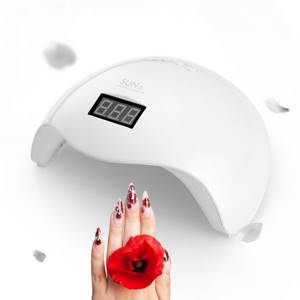
You can’t do without forms, lint-free napkins and a cleaner. The most important tool after a brush, perhaps, can be considered a file with an abrasiveness of 100\180 grit. Some craftsmen use a machine with a suitable cutter for sawing, but this requires considerable skill.
UV gel for nails - how to use correctly
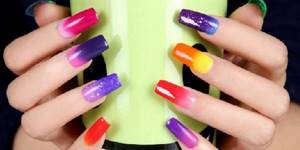
Neatly sharpened and varnished nails always attract the attention of others.
But women know how easily a manicure gets ruined due to the natural fragility of the plates and housework. UV gel or shellac will help preserve the beauty of artificial nails; gel polish is a cosmetic product that allows you to have smooth, shiny nails for 2 to 3 weeks.
Preparing the nail plate
If the material comes into contact with the pterygium, cuticle or skin, detachments cannot be avoided. Therefore, the preparatory stage is extremely important. There are no special recommendations when working with single-phase gel: do your manicure in the same way as you would before working with any other material.
Thoroughly clean the nail from the pterygium, move it back, cut and polish the cuticle with a ball-shaped cutter, and treat the areas adjacent to the side ridges. File the ends with a file with an abrasiveness of 180 grit. Polish the surface of the nail plates with a buff, carefully remove dust, wipe the nails with a lint-free cloth soaked in a special cleaner.
Experts do not recommend using pharmaceutical products with alcohol. This component is quite aggressive: it can dry out the skin or react with materials, which will complicate the work and ruin the result.
Composition and purpose
Professional UV gel Lina, intended for nail extension, contains 100% isopropanol. The product is intended for manicure and pedicure.

Jars of nail gel UV gel Lina White/Clear.
The extension process is carried out in 3 stages:
| Stage | What they do |
| Base | Initially, a base coat is applied, which is responsible for strong adhesion to the surface of the natural nail plate. |
| Building | At this stage, the shape that the client desires is modeled. |
| Finishing | Upon completion, the surface of the nail plate is covered with a fixing layer, which prevents rapid wear of the material. The fixative is also responsible for the glossy, velvety or matte surface of the nail. |
UV gel Lina nail extension product is considered a ready-made professional kit, which makes it possible to perform decorative techniques using ultraviolet gel. Additionally, for the procedure it is necessary to prepare an ultraviolet lamp required for polymerization.
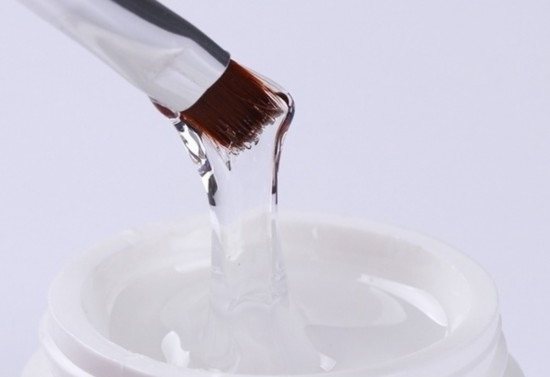
UV gel Lina Clear
The kit includes the following tools:
- ultraviolet gel required for the top coating of the plate, 14.18 g;
- manicure glue in the amount of 1 piece, volume 3 g;
- gel brush;
- file;
- 10 forms;
- 20 French tips;
- 20 square tips;
- napkins in the amount of 4 pcs.
- cleansing composition 56.7 g;
- 2 transparent gels with a volume of 14.18 g;
- white gel in the amount of 1 pc., 14.18 g;
- 1 pink gel, 14.18 g.
Primer: why you need it, which one to choose, how to use it
Some masters consider this stage optional. But if there are no obstacles (for example, allergies), it is better to use a primer. It acts like double-sided tape, reliably adhering the material to the surface of the nail.
The primer also solves other problems: eliminates excess moisture, prevents the development of infections, degreases, and slightly dries the surface.
There are so-called acidic and acid-free products. In fact, both contain acids, but in the second their content is lower. This option is suitable for treating nails before applying polish.

And before applying single-phase extension gel, nails must be coated with an acid primer. It is important that the material does not come into contact with the skin. The product dries in air, it does not need a lamp. You can begin further stages of coating in a minute. But if more than half an hour has passed since applying the primer, the procedure must be repeated. Therefore, there is no point in covering all 10 nails before starting work.
Briefly about the extension procedure
It is impossible to make gel nails without gel - a special material that hardens under ultraviolet rays. The gel does not cause allergic reactions and does not irritate the skin around the plate.
The gel nail extension system is akin to the work of a sculptor: the master applies the material to the nails and literally sculpts, creating beautifully shaped transparent nails that are similar in structure to natural nail plates.
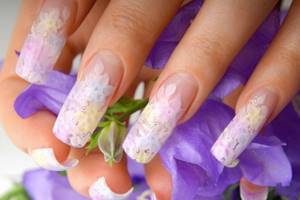
With well-groomed hands a woman becomes much more confident
The surface is leveled, a glossy shine appears on them thanks to the skillful actions of a master who knows how to do gel nails correctly. The extension procedure lasts quite a long time: at least three hours are needed to make gel nails without violating the technology.
Review of popular products
Which single-phase gel for nail extension is better? There is no definite answer to this question; each master has his own favorites. But we can highlight several products, the reviews of which are the most numerous.
- RuNail can be called one of the most popular. Available in several shades, it files and presses well, and is well suited for beginners. Course teachers often choose this material: nail extensions with RuNail single-phase gel are discussed step by step during training. It is suitable for professionals with a lot of traffic, and for those who only do their own nails. Low cost is one of the advantages of the product. A jar of 15 grams will cost on average 250-300 rubles.
- Formula Profi is a brand loved by many craftsmen. For a jar of single-phase gel “A-Profi” you will have to pay about 450 rubles. Once polymerized, the gel turns into a very durable monolith. It is easy to file and does not create a large amount of flying dust.
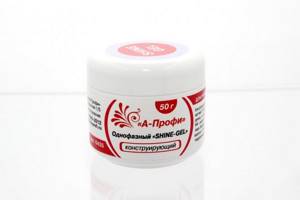
- UV Lina is a product that many craftsmen who are passionate about shopping on Chinese sites have become familiar with. The cost of one jar weighing 15 g is only about 100 rubles. Reviews about this product are extremely contradictory. Some claim that the single-phase gel for nail extension “Lina” copes with the tasks perfectly. But there are also those who warn potential buyers against the terrible smell, poor packaging, and allergic reactions.
- Cosmoprofi gel is available in several shades. It is loved by manicurists due to its comfortable consistency of medium viscosity, average price (350 rubles / 15 g), and good wearability.
- Irisk single-phase gels are praised by many for their lack of odor and large palette of shades. But in reviews, some note a runny texture, due to which the material tends to flow. Not everyone is happy that the time stated by the manufacturer is not enough for polymerization.
What to do after the decision is made
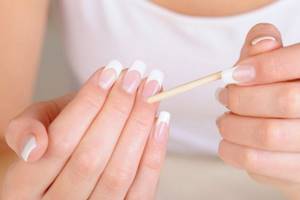
If the information above has not discouraged you from growing beautiful nails, let’s get started. First of all, you need to decide on the shape of your nails, the material for extensions, and of course, purchase the necessary tools if you don’t have them.
Form
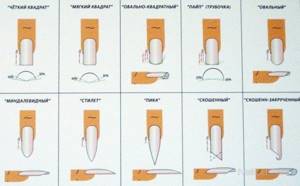
To understand what shape of nails you want, look at the photo. Choose a shape based on your own preferences and be sure to check out what kind of manicure men like.
Please note: the most convenient and least traumatic shapes are the classic oval or square.
Material for length
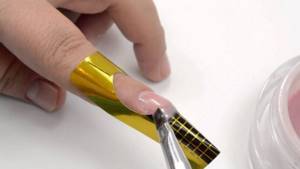
Choose the most suitable material between the two proposed options:
- Tips False nails made of plastic. Most often they have a transparent structure. Thanks to tips, you can achieve any , even the most unimaginable length. They are convenient to use if the nail plates are narrow.
- Forms are a more popular and convenient type of extension. They exist in Teflon or paper form. If you plan to do nail extensions only for yourself, you can purchase Teflon forms. Their disadvantage is that they require constant disinfection. Paper forms are disposable, which is undoubtedly more convenient.
Materials
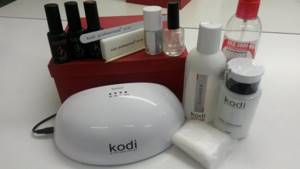
Prepare materials and tools to perform extension work:
- Teflon molds or tips. If tips are selected, then glue for them
- Gel composition
- Home lamp with ultraviolet rays
- Finish coating
Supporting materials:
- Tack remover
- Primer
- orange stick
- Files, tweezers
- Composition brush
- Polishing pad
Extension on forms
Let’s make a reservation right away that this material is not suitable for the top forms that are fashionable today. Only classic lower forms can be used.

There's no need to rush. If you have little experience yet, work with each finger separately, drying each layer. Before you start using single-phase extension gel, nails should be thoroughly treated, degreased and coated with primer.
- Adjust the shape to the nail, making cuts if necessary so that the base fits as tightly as possible.
- Carefully glue the edges together, making sure that all symmetrical elements match completely. You can use a stationery stapler to prevent the form from coming unglued while working.
- Using rubbing movements, apply the first base layer of single-phase gel, starting from the end and moving towards the cuticle. Avoid contact with skin! If the gel is baked on the cuticle, detachments are inevitable.
- Cure the material in the lamp for as long as the manufacturer recommends. Evaluate the result by lightly tapping the surface with a pusher.
- Place a drop of gel on the mold, where the free edge will form. Use confident strokes to distribute the material, following the markings. Shape the apex depending on the desired length. Place in a lamp to dry.
- Carefully evaluate the surface, if necessary, add a little gel to the gaps. File off unnecessary bulges with a file. If you don't plan on doing the design, simply cover the nail with another thin layer of gel, turn your hand over, palm down, and let the material level out. Send the work back to the lamp.
- You can start sawing. Follow the direction of the side edges, check the symmetry of the nail. Single-phase gel does not need a topcoat, but you can use, for example, a satin or velor finish for decorative purposes.
- All that remains is to remove the dust and remove the stickiness with a special product.
Why do you need to apply a top coat?
The final stage in shellac coating is the topcoat.
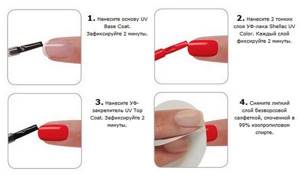
Its main purpose is:
- alignment;
- drying;
- preservation of bloomed varnish;
- strengthening
Recently, coatings have appeared that also perform decorative functions. There are top coatings that allow your manicure to glow under the influence of ultraviolet light and make your nails glossy or matte. Gives a sandy texture.
It should be remembered that in order to make gel polish at home, you need to think about how the manicure will look if you apply a coating with “special” actions.
Polymerization time
Always pay close attention to the manufacturer's recommendations if you have purchased a new single-phase nail extension gel. How to use the material, how long to dry the layers and other recommendations - all this is usually indicated on the packaging. On average, it takes 1-3 minutes to dry the gel in a hybrid lamp for each layer.

Contraindications
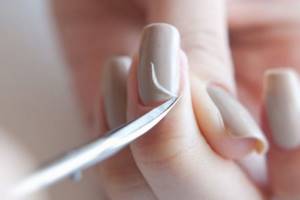
Gel extensions have not many contraindications , but if you see yourself in at least one point, you will have to give up the idea of making beautiful nails at home or in a salon:
- Cuts, open wounds, cuticle inflammation
- Diseased nails: brittle, peeling, uneven, fungus
- Taking antibiotics, chemical irradiation procedures.
Why does the gel bake in the lamp?
In reviews of single-phase nail extension gels, you can often find indignation about burning during drying. This occurs due to the fact that the material passes from one state of aggregation to another, crystal lattices are formed. Chemical processes are accompanied by the release of heat.
It is enough to simply reduce the lamp power (if this function is provided by the equipment manufacturer). When working with unregulated lamps, you can simply remove your hand for a few seconds, allowing the heated material to cool slightly. As soon as the gel “sets”, the burning sensation will go away.
It should be understood that this is not a lack of material, but a technological feature.
Modeling on tips - for beginners
The gel nail technique has two methods, when extensions occur either on tips or on forms. Tips are artificial nails that are first glued to a natural base, and then covered with gel and further modeling occurs.
Tips or forms? The first method requires less time, but the hands also do not look natural enough. Extensions on forms guarantee a more natural manicure and such surfaces are much easier to remove if desired.
Beginners should start with the first technique. For you - a video lesson about modeling on tips:
Common questions and answers
Most often, beginners wonder whether it is possible to use products of a three-phase system as a single-phase gel. Unfortunately this is not possible. But a single-phase one is suitable instead of a modeling or finishing coating.
It is highly undesirable to use this material for French lay-outs. In any case, you will need at least two gels of different colors, so what is the point of using a single-phase one? It is much easier to use a three-phase system.

Doubts are often raised about the possibility of using a single-phase gel to strengthen nails without extensions. The material is excellent for these purposes. It can be used as a base for gel polish and for repairing broken nails.
What is gel paint
Gel nail paint is somewhat similar to regular gel polish, but it is used only for drawing some elements in the design. The thick mixture has high viscosity and dense pigmentation. The material is dense in texture; in one layer it is able to recreate a bright background for the nail plate.
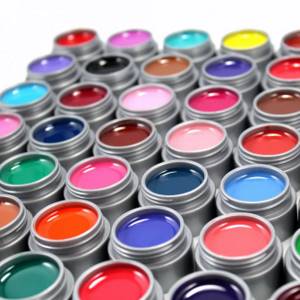
There are a huge number of different shades on the market that can be used to create even the most detailed and complex designs. The gel paint is dried in a UV or LED lamp in the same way as a simple gel polish. The universal material can be used in any decor (aquarium manicure, French manicure, Chinese painting, monograms, veil and much more).
Varieties
There are two types of gel paint:
- Gel nail paint with a sticky layer is suitable for manicure using the casting technique. After applying the paint, you need to carefully print the matte side of the foil onto the nail. After sharp tearing off, due to the stickiness of the gel paint, unusual patterns will appear on the nail.
- Gel paint without a sticky layer is suitable for artistic painting, for drawing a smile in a jacket or as a plain coating.
Characteristics
Gel nail paint has a semi-viscous consistency, but does not spread or bubble and is very convenient to apply to nails. Gel nail paint has a wide range of characteristics:
- has a large color palette;
- the compositions can be mixed with each other to achieve a certain shade;
- using paint you can draw any small details;
- the product dries only after polymerization, which means that the design can be adjusted before drying;
- for application there is no need to file off a large layer of the nail plate;
- an excellent alternative to gel polish as a plain base;
- gel paint designs have a pleasant surface and contrasting color;
- manicure with gel paint lasts 2-3 weeks;
- the paint does not dry out for a long time, it does not need to be constantly stirred;
- the pigment does not settle to the bottom of the jar;
- has a dense consistency;
- has excellent saturation;
- economically used.
Color gel VS Gel paint
Several years ago, craftsmen used colored gel. It has a similar consistency to paint. Essentially, it is a gel that is mixed with a specific color pigment. But this very pigment has the peculiarity of settling at the bottom of the jar. To do this, each time you apply it, you need to mix it well. The gel lays on the nail in a thin layer, but its color is weakly visible. Colored gel requires a substrate.
In order to tint the entire nail, you need to apply about 4-5 layers. Each layer must be dried in a lamp. The gel is most suitable for interior designs or for laid-out jackets. But he is not able to cope with drawing small details.
Over time, colored gel paints began to appear on the markets. They do not need to be stirred before use, they are quite dense and pigmented. The materials fit perfectly on filed nails. One coat is enough to get a rich shade of coverage. Gel polish paint is a convenient and acceptable option for interior and surface designs.
